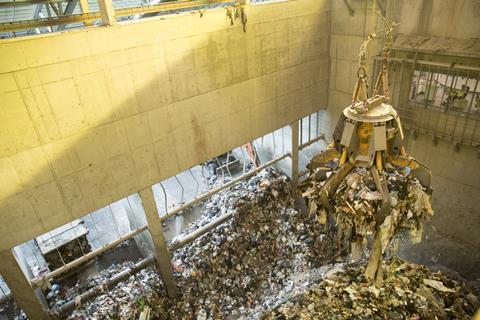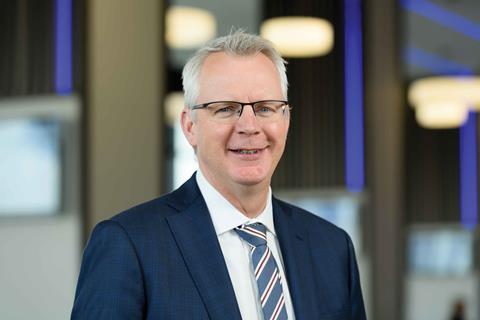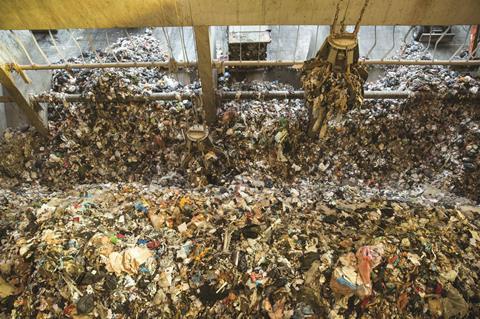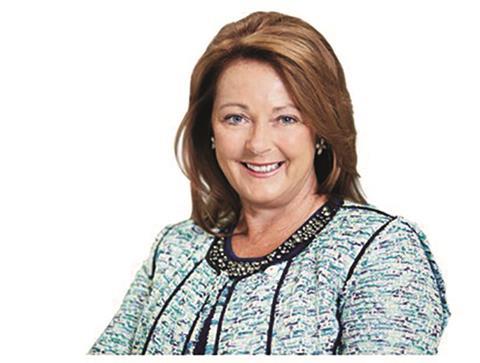InterserveŌĆÖs energy-from-waste crisis has prompted fears of another Carillion-style collapse, as the company takes drastic action to rebalance the books. Dave Rogers reports on how the firm is fighting its way out of the mess

For those with an eye on the small print, page 13 of InterserveŌĆÖs 2017 results statement made for eye-watering reading. Between 2015 and 2017, the firmŌĆÖs losses from its energy-from-waste business have rolled up to ┬Ż216.6m ŌĆō which works out at more than ┬Ż70m a year. ŌĆ£ItŌĆÖs been a sobering experience,ŌĆØ says Gordon Kew, the boss of InterserveŌĆÖs UK construction arm, which accounts for just under one-third of the firmŌĆÖs total revenue.
Chief executive Debbie White must have been wondering what her predecessor Adrian Ringrose had got the business into when she took her up post at the beginning of last September. By October last year, less than two months after she joined, White recalculated that it would cost another ┬Ż35m on top of RingroseŌĆÖs previously estimated ┬Ż160m to pull the business out of the sector.
City watchdog the Financial Conduct Authority also wants to know why the cost kept jumping, last week announcing an investigation into the way the firm disclosed information over a seven-month period up to RingroseŌĆÖs announcement last February that the cost of getting out of the sector was going to be ┬Ż160m.
ŌĆ£Having [energy-from-waste] as a separate business allowed me to run the rest of the [construction] business unencumberedŌĆØ
Gordon Kew, Interserve
All this trouble has had a company-changing effect. It has forced a refinancing and heralded a major restructuring of the group.
Interserve is hardly alone in coming a cropper on a bad punt. Earlier this year, Galliford Try unveiled a rights issue to cover the expense of ballooning costs on its scheme to build a bypass around Aberdeen. So far it has raised ┬Ż144m.
And back in 2013, steelwork contractor Severfield was forced into an emergency rights issue after seven problem jobs ŌĆō notably its work on the Cheesegrater building in the City of London ŌĆō saddled it with a company-threatening debt pile.
ŌĆ£We were quite explicit,ŌĆØ said SeverfieldŌĆÖs new chief executive Alan Dunsmore, who took over from Ian Lawson earlier this year. ŌĆ£Without the shareholders contributing the ┬Ż45m, we wouldnŌĆÖt have survived.ŌĆØ For Interserve, energy-from-waste has had a similarly transformational impact.

Good intentions
When it signed its first deal to build a facility in Glasgow in July 2012, Ringrose said the ┬Ż146m facility would ŌĆ£make a real difference to Glasgow and the surrounding area and we are proud to be involvedŌĆØ.
Interserve stated the scheme would be able to handle between 175,000 and 200,000 tonnes of rubbish a year. This would have meant that 90% of the rubbish collected by GlasgowŌĆÖs bin lorries would have avoided ending up in landfill and would have been able to generate up to 15MW of electrical power. At the bottom of the announcement, the firm added, somewhat unfortunately given the future, that its vision was ŌĆ£to be the trusted partner of all our stakeholdersŌĆØ.
However, in November 2016, Ringrose said he was stepping down and just a day after, Interserve told the Stock Market it had been served notice on the Glasgow job.
It left the job at the end of that year, with Viridor, a recycling and waste management specialist, not holding back in announcing the termination of the deal. ŌĆ£Interserve has continually and repeatedly failed to meet delivery milestones,ŌĆØ said capital projects director Alan Cumming. ŌĆ£Viridor is no longer able to tolerate further impacts on this important environmental project.ŌĆØ
Such was the scale of the mounting losses from energy-from-waste that the firm decided in October 2016 to separate out its exited business, with KewŌĆÖs predecessor Ian Renhard taking charge of the mess, and reporting directly to main board director Dougie Sutherland.
Kew says: ŌĆ£Having it as a separate business allowed me to run the rest of the [construction] business unencumbered.ŌĆØ
Other challenges
But Kew has not been immune to having to deal with other problem contracts, as the firm flagged up problems on a handful of schemes that helped to send the division to an operating loss of ┬Ż19.4m last year from 2016ŌĆÖs operating profit of ┬Ż25.2m.
Kew says the four loss-making jobs are a mixture of building and civils work. He adds: ŌĆ£Like everyone, we had problems with some jobs won in the recession. We won a few large, complex projects.ŌĆØ He says that work on the jobs, which the firm has declined to name, was complete but negotiations on final accounts were continuing.
InterserveŌĆÖs UK construction income is split 80% in favour of building work, with the remaining 20% focused on civil engineering jobs in four sectors ŌĆō highways, water, flood defence and airports.
Margins are better in civils, Kew says, and adds the business is eyeing margins of 3% by 2020. Anything more would be difficult, he admits. ŌĆ£I donŌĆÖt think the way the market operates in the UK [that a higher figure] is achievable.ŌĆØ
ŌĆ£[Debbie White] is adopting a sensible and plausible recovery strategy from an operational point of viewŌĆØ
Kevin Cammack, Cenkos
After its bruising energy-from-waste experience, the firm wants more bread-and-butter work. A few years ago, the firm found itself preferred bidder, along with China State Construction Engineering Corporation, to build the ┬Ż1bn One Nine Elms twin tower scheme in London, designed by US architect KPF.
The news left some in the industry scratching their heads at the fact that Interserve, not known for high-rise work in this country, had won the job ahead of more obvious tower builders. It was Chinese developer Dalian WandaŌĆÖs debut UK project and so a little more high-profile because of that. But this puzzlement became academic after Interserve was replaced, first by Balfour Beatty, and eventually by Multiplex to carry out the work, after failing to agree costs.
Interserve does have experience of high-rise towers at its international arm but Kew admits: ŌĆ£ItŌĆÖs not a job we particularly pursued ŌĆō they came to us. I maintain weŌĆÖd have delivered it [but] if the situation arose today we wouldnŌĆÖt bid for that type of work.ŌĆØ
The companyŌĆÖs largest ongoing project is a ┬Ż200m scheme to build a new facility for the Defence and National Rehabilitation Centre at Loughborough in Leicestershire.
Kew says turnover at UK contracting will have dropped this year and adds that he is comfortable with income of anywhere between ┬Ż700m and ┬Ż1bn. He wants more work with fewer clients, and in the wake of CarillionŌĆÖs collapse is hoping for something of a sea change across the sector. ŌĆ£The main contractor-client relationship is about a balanced and appropriate sharing of risk,ŌĆØ he says.
The firm has taken on some of CarillionŌĆÖs former staff. ŌĆ£TheyŌĆÖre well-trained, experienced members of the industry. In terms of the demise of Carillion, itŌĆÖs extremely sad. They go back to the Tarmac days,ŌĆØ he comments. ŌĆ£I do hope the industry learns from this and behaviours are moderated.ŌĆØ

Fire sale?
Mention of the C-word has had some wondering whether the energy-from-waste debacle will force Interserve into a fire sale of some of its more profitable parts of the business ŌĆō the star performer is its equipment services division, RMD Kwikform, which posted operating margins of 23.8% last year.
Ringrose mulled over selling the business a few years ago, but instead the firm decided to withdraw its equipment services business from less attractive markets such as Colombia and Singapore and pared back its product range.
Cenkos analyst Kevin Cammack has previously said Interserve might have to look at selling off RMD. The recent refinancing has bought it some time but Cammack warns with that with debt set to peak between at ┬Ż650m and ┬Ż680m in the first half of this year, a sale could still rake in cash if it fails to get debt down sufficiently.
ŌĆ£The obvious issue with Interserve is how it pays down the debt,ŌĆØ he said in a brokerŌĆÖs note earlier this month. ŌĆ£[With] scheduled repayments of the term loan aggregate ┬Ż130m in financial year 2019 and financial year 2020 [ŌĆ”] It seems to me that at the macro level, Interserve has two yearsŌĆÖ [funding] grace, by which time it will raise new equity or be forced to make a strategic business sale [of equipment services].ŌĆØ
WhiteŌĆÖs ŌĆ£Fit for GrowthŌĆØ restructuring plan is promising annual savings of ┬Ż50m from 2020. It has already seen the firm spend more than ┬Ż16m on redundancy payments in 2017 ŌĆō and White was only at the firm for four months last year.
Cammack says White, who picked up close to ┬Ż526,000 in salary and benefits for her four monthsŌĆÖ work last year, ŌĆ£is adopting a sensible and plausible recovery strategy from an operational point of viewŌĆØ and adds that, if nothing else, her and finance director Mark WhitelingŌĆÖs decision earlier this month to buy a pile of shares in the firm ŌĆ£at least sends out the right message that new management have faith in their recovery plan ŌĆō and their own ability to see it throughŌĆØ.

Seeking ┬Ż100m
But he says the firmŌĆÖs debt levels means it will have to generate more than ┬Ż200m in the next couple of years and adds: ŌĆ£In short, Interserve needs to find circa ┬Ż100m of disposals or new equity.ŌĆØ
It has begun marketing its stake in a ┬Ż200m property scheme in Edinburgh where the firm had been working with Tiger Developments to build offices, hotels and retail outlets on a former goods yard next to Haymarket railway station.
But Cammack adds: ŌĆ£The PFI cupboard is now pretty bare so eyes once again will turn to equipment services, the one unquestionably valuable asset in its portfolio. The prospect of new equity could start to haunt the share price if progress on disposals and cash flow prove to be slow.ŌĆØ
Jitters surrounding energy-from-waste are never far away and ViridorŌĆÖs parent company, the listed water utility Pennon Group, said in March it was in discussions with Interserve ŌĆ£with regard to the contractual settlementŌĆØ. However, Kew says: ŌĆ£We donŌĆÖt concur with their view of life and itŌĆÖs a position weŌĆÖre entirely comfortable with.ŌĆØ
The firm has completed work on all six of its energy-from-waste schemes apart from its job at Dunbar in Scotland. It is on site carrying out commissioning work at plants in Derby; Margam, south Wales; and Rotherham, South Yorkshire.
Kew says the firm expects to be finally out of energy-from-waste by the end of the year. He adds: ŌĆ£We went into a new sector that weŌĆÖd thought weŌĆÖd prepared for and clearly we hadnŌĆÖt.
ŌĆ£[ItŌĆÖs] forced a refinancing and itŌĆÖs a major catalyst as to why we had to undergo restructure of the business.ŌĆØ
Kew admits the firm came unstuck when it agreed to carry out complex process engineering work at Derby and Glasgow, with Interserve becoming responsible for making sure the plants produced their stated MW output. ŌĆ£There was definitely a capability gap.ŌĆØ
He says the firm won too many jobs too quickly and adds: ŌĆ£We do process work in other sectors but we hadnŌĆÖt lived and breathed it. ItŌĆÖs a tough old market.ŌĆØ
Asked why Interserve has had to repeatedly revise upwards the amount of money it has blown on energy-from-waste, he says: ŌĆ£In my experience, once youŌĆÖre in a difficult position on a loss-making job, itŌĆÖs very hard to bite your lip [ŌĆ”]. Sometimes you can spend too much money trying to recover a lost cause.ŌĆØ
Historians of recent UK construction history can point to many examples of catastrophic decisions made with good intentions, from those that plagued John Laing ŌĆō when it was put up for sale by the Laing family back in 2000 the hope was it would fetch ┬Ż100m; it ended up being flogged for ┬Ż1 ŌĆō to Carillion more recently. What happens in the coming months is unclear, but the keener historians on InterserveŌĆÖs board will know the energy-from-waste saga is not over yet.



























No comments yet